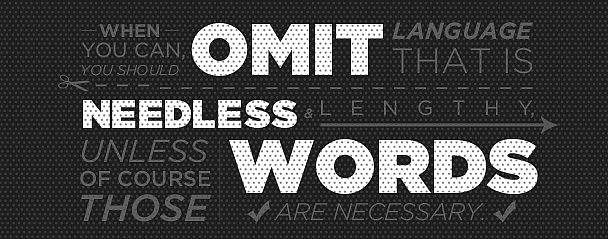
By Corey Eridon, from Inbound Hub – http://bit.ly/UdAOb9
You and your audience have something in common: You want to write less, and they want to read less.
It’s not that your content is boring — it’s that we don’t even make time to read stuff we want to read. I skim articles I voluntarily click on because I have 20 other tabs open (and other stuff I should be doing, anyway).
Make your dream of blogging less come true by cutting the length of your content in half. Here’s how.
Make your intros shorter.
I’ll venture a guess most people didn’t read that intro I just wrote, and scrolled to the first bold header they saw.
Don’t worry, I do it, too.
Write an intro, but don’t belabor the point. Generate some empathy, tell a quick story, cite a stat, whatever — then get on with it.
If you need help writing intros, read this post, “How to Write an Introduction.”
Cut the qualifiers.
We’re all so concerned with not offending anyone, leaving people out, or being presumptuous that we’ve defaulted to a ridiculous extreme — adding all the qualifiers we can to ensure we don’t get called out by readers.
Let’s use my intro in this post as an example. I made a presumption — that you don’t like to blog. I also might’ve insulted some people by saying people don’t like reading what they write. I could have added every qualifier on earth to try to make sure I didn’t offend or presume … but these are low stakes here, and frankly, the qualifying gets exhausting. We’re talking about writing for pete’s sake.
If it’s low stakes, cut the qualifiers for more concise copy.
Don’t assume the lowest common denominator.
“Explain it to me like I’m a three year old.”
That’s a really helpful approach to take with how-to content that requires a lot of attention to detail. But it isn’t required for every post you write. Assume your readers don’t need you to over-explain concepts. Even if a few of them do, you’ll find most will rise to the occasion and appreciate the opportunity to read something that asks them to use their brain cells.
And if they don’t, hey, at least you’re elevating the conversation for everyone else.
Write like you speak.
The last sentence I wrote up there originally had some business babble creep in. It said, “at least you’re elevating the conversation for the rest of your audience.”
The rest of your audience? What am I really trying to say? The rest of your audience = everyone else. Just say that.
So I did. The babble made my sentence longer, so I cut it.
Give word choice a thought.
“The difference between the right word and the almost right word is the difference between lightning and a lightning bug.” – Mark Twain
Finding the right word for something can remove entire clauses from sentences, sentences from paragraphs, paragraphs from prose. It so clearly expresses your point that you don’t need to over-explain it.
Use pretty pictures and damn good data.
A picture’s worth a thousand words. A good data point’s worth at least ten. Pictures and data help you get a point across in fewer (or no) words. Lean on visualizations to explain complex concepts, and data to help strengthen your arguments.
Let go of the idea that there’s a perfect word count.
This post will explain why in more detail. Here’s the condensed version: Write as much as you need to make your point. And when you’ve made the point, stop.
